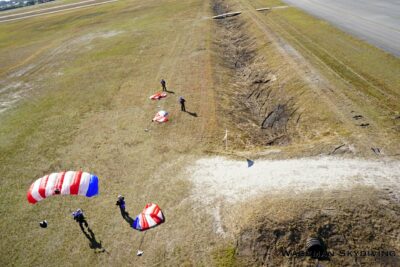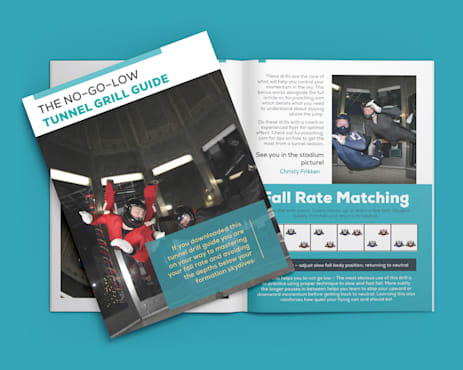US Nationals FAQ
Monday, August 23, 2021

How does this US Nationals thing work? What are the questions you hear everyone asking every year? Look here for help!
Special thanks to super-judge Jim Rees for helping me with these articles and provide great insights!
You can find the official rules and descriptions in the skydiver’s competition manual.
Where is it? When is it?
US Nationals moves around the country each year. The USPA Board of Directors decides on a winner from bidders who make a presentation.
The host will then decide on the dates and schedule, usually favoring the best local weather. The earliest Nationals would be early September (IL), and the latest was in November (FL).
You can check out the USPA site here for the most current information.
Do I need to be there the whole time? What if I have to leave early?
Each team member needs to be there before registration closes and until the last round is officially signed. The latest this would be is sunset on the last scheduled day of the competition.
If you leave before it finishes, and you have an alternate, you can use them. If you do not have an official replacement and go before the meet completes, your team will forfeit the meet. You would lose your money.
The meet director can grant you “guest” status if you found someone to fill in for the meet. Your teammates could jump but would not qualify for a medal.
Can anyone compete? What qualifications/licenses do I need?
You must be a current USPA member with 100 jumps or more who is 18 years or older to compete in anything. Beyond that, there are rules in different divisions governing licenses required, US residency status, and prior competition success. If you don’t meet some of these requirements, you can probably still compete as a guest team – meaning you will be judged and scored, but you can’t win any medals.
Licensing
You need the following licenses to compete in these divisions:
FS Intermediate/Advanced – B License or FAI equivalent
FS Open – C License or FAI equivalent.
Residency status
Jumpers in the open division are competing to represent the US at international competitions. Because of this, all the members must be eligible to represent the United States. Specifically, they must be US citizens, possess a Resident Alien card I-551, or have an I-551 stamp. Finally, you must be eligible to compete for the US under FAI rules – in short, you can’t represent different countries without waiting a while between world meets.
For advanced, intermediate, and beginner divisions, the rules are more relaxed. In 4-way, one member doesn’t have to meet representation requirements. In an 8-way, two members can be accepted.
Past competition limits
Finally, intermediate and advanced teams have restrictions on competitors who have won in prior years. In 4-way, you can have one exceptional person; in 8-way, you can have two. The video person doesn’t count against this.
Besides your one allowed ringer, no one else on the team can have a gold medal in the division you are competing in the last five years. Nor can they have won any medal in a higher division in the previous five years. Nationals and significant international events both count for this restriction.
What does “guest” status mean? Why is there a (g) next to a score?
Teams who do not qualify can usually register as a guest team. Guest teams compete and get judged but won’t get a medal if they win. The meet director and host have discretion on this, but I’ve never seen anyone denied.
If something goes haywire mid-competition and the team can’t continue legally, sometimes the meet director will allow the team to carry on as a guest. For example, if someone is hurt and doesn’t have an alternate, you might finish with an unregistered person if the meet director allows.

Female 4-way event
All teams in all divisions can be co-ed at Nationals. However, the USPA must select an all-female team to represent the US. To qualify, the team registers in the open division. If an all-female ranks with co-ed teams, they get a regular open medal in addition to a female 4-way medal.
The video person can be male or female. There is a transgender policy for competition and record purposes.
Can I do more than one team in a single event? Share a videographer in an event? Be a double alternate?
Nope. Never.
You can compete in different events. If the dates overlap and run concurrently, you will be subject to reduced time on the ground.
What do the crossover days mean? When does 8-way start?
The schedules for events often overlap. This gap means that the second event could start as early as the first day listed. If you are doing the second event, plan on being there the day before it starts.
The second event could technically happen even if the first event hasn’t finished; it is theoretically allowed to run both events concurrently, as long as there is adequate time to switch back and forth.
In reality, I have never seen this happen. 4-way always finishes before the start 8-way. The hypothetical is terrible inevitable weather. If a hurricane or some other disaster is imminent, the meet management will attempt to complete at least one round in every event to choose the US Champions.

How many jumps is it? How many jumps a day?
The 4-way and 8-way events are ten rounds, with a possible round 11 tiebreaker. There are six rounds in 16-way and 10-way.
There are no limits to how many jumps a meet can arrange. You could do all 11 if sunlight permits. However, on average, meets usually do 6-7 jumps the first day and the remainder on the second day. I had seen an exception when the forecast was terrible – I did all ten 8-way jumps in one day with Moxie at SDC one year (and it was a blast!).
What division should I go in? Are player coaches allowed?
There are no point average guidelines for divisions at nationals. There are restrictions regarding who has won in prior years. See eligibility requirements for details.
How are ties decided?
If your team ties after ten rounds, you will get one round jump-off. If that fails to break the deadlock, they start looking for the highest round scores going backward round by round. If somehow two teams have precisely the identical scores for every round, they will time both teams to the last scored points on the previous jumps to see who was faster.
Fun Fact from Guest Judge Jim Rees: Did you know that Accuracy (tuffet) has no set limit on the # of tie-break rounds — other than the Meet Director deciding that enough’s enough? Most World Meets go two or more TB rounds.
What if I have a complaint? (meet director, protest)
Your first recourse is to talk to any of the meet officials who are most likely to resolve the issue.
You can escalate the situation to a protest and have it considered by a jury – but I’d proceed carefully. Most protests are denied, wasting your cash. A good rule of thumb is you can’t protest a score – only a rule, so if you want to complain about a bust, tough luck and train harder next year.
Of course, the system is there to help you if you have a legitimate claim. I’d suggest talking to experienced competitors about how to proceed if you genuinely need it.
What is the loading order?
Team exit order is assigned by the meet director, typically randomly at the draw. Some groups will try to shuffle their plane according to canopy sizes, but you do not have to agree and can insist on the assigned order. If everyone consents for reasonable reasons, switching within a plane doesn’t cause a problem for FS. There are some exceptions for canopy piloting and accuracy landing.
What kind of rooms/video watching areas are there?
Team room availability varies tremendously from DZ to DZ. Call well in advance to see if they have team room options. If not, be prepared to bring everything you want/need.
How do I find out my score? What were my busts?
They will play the judged videos in assorted viewing areas. Most scoring systems upload them too.
There will be an area with cubbies or push pins sorted by team order. They post a sheet for every round that has your score and busts. Somewhere there will be a sheet signed by the chief judge; this notice is your official score.
If you are confused about a bust, ask someone qualified to watch your jump and help you understand. Remember, just like all sports, you might feel “robbed” by the judges. But you also can get lucky; it usually evens out.
Why does the screen show a different score while they are judging it?
Most scoring systems used will flash points and busts from every judge, but the numerical score shown is from one judge. After everything finishes, the tabulation can change. Don’t get too excited about your score until you see the final screen.
How much time will I have in between jumps?
You get an hour from arriving back on the dropzone. If you are doing two events simultaneously, they can cut your time to 45 minutes.
If you land off, you may talk to the meet director to get an extension. If you have a cutaway, gear issue, or minor injury, you can often get more time, too – talk to the meet director.
However, this time gap gets “waived” all the time. Meet management keeps the meet moving, so calls can be faster if the meet director informs the competitors. If the calls are too fast for you, talk to the meet director.
How much time from the draw?
You have at least two hours between the time they give you the draw and the meet’s start.
Can you get disqualified?
Definitely! Gross safety violations are a big one. You can get kicked out of one event or the whole meet, depending on how stupid you are.
Blatant violations are a thing too. Sabotage, cheating, and underhandedness can get you the boot.
Can we do tunnel during the meet? Fun jump? Work?
Nope. After the draw, no one can do any non-competition jumps or tunnel. Doing so is grounds for disqualification.
What does “spirit of the rules mean”?
From super-judge Jim Rees:
Spirit of the Rules can be invoked when the other rules are ambiguous and a decision can be clearly arrived at based on fairness and equal treatment. In 2017, when a USPA staff videographer was involved in a landing injury of a competitor, we allowed the team to alter their roster and continue to compete officially based on Spirit of the Rules. It would have been unfair to the team to be subjected to unequal conditions created by meet management.
How do we know what the jumps will be?
The is an extensive briefing the night before. At that meeting, they will hand out the draw with the jumps you must do.
Can we get a rejump?
Sometimes. See my upcoming rejump article.
When is the medal ceremony? Buffet?
The medal ceremony is the afternoon or night the event finishes. The buffet and shindig are scheduled beforehand.
What if the video guy misses the exit? Falls off? Video failure?
The video guy is part of the team, so you won’t get the point if they miss the point. If the video guy falls off, the clock will start when they leave. The team will get a 20% penalty for anything they manage to score on video.
Videographers should wear two cameras. If there is a complete double video failure, you will probably score 0, but you can appeal through a special video jury for a slim hope.
What are the video requirements?
All video equipment must provide a high-definition digital-video file in a compatible file format approved by the Video Controller containing a 1080-type digital signal with a minimum frame rate of 25 frames per second through a minimum class-10 memory card. The ideal is 1080p at 60 fps. No 4k, please!
You can’t mess with your video with software, but image stabilization as part of the recording process is ok.
Can we go around? What if the video fails on jump run?
They must give you two passes if you request. You can ask for more, but you might be denied. If you have a good reason – weather or safety – you can ride the plane down. If you have a reasonable reason, they should give you a rejump.
What are the wind limits?
Open and advanced are 11 meters/second (24.6 mph, 21.3 knots). Intermediate is 9 meters/second (20.1 mph, 17.4 knots).
What is exit altitude for 4-way? 8-way?
10,500 feet for 4-way intermediate, advanced, and open. 13000 feet for 8way. 12500 for beginners.
What is the competition speed for the plane?
From the SCM:
The Meet Director and the Chief Pilot will determine the aircraft speed, torque, and flap settings at the time of exit, except: • Twin Otter: 85 to 95 knots (indicated) inclusive.
Tags: 4way, 8way, competition, rules




